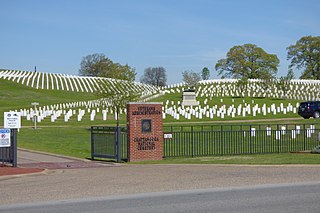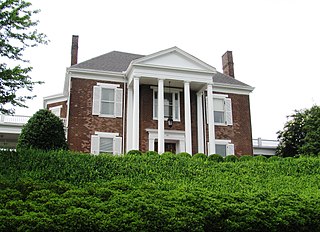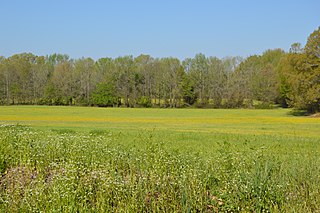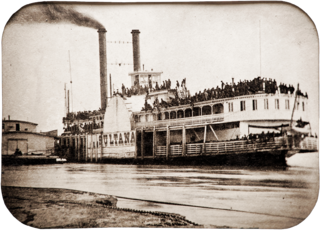 W
WThe American Civil War made a huge impact on Tennessee, with large armies constantly destroying its rich farmland, and every county witnessing combat. It was a divided state, with the Eastern counties harboring pro-Union sentiment throughout the conflict, and it was the last state to officially secede from the Union, in protest at Lincoln's call for troops. Although Tennessee provided a large amount of troop support for the Confederacy, it would also provide more soldiers for the Union Army than any other state within the Confederacy.
 W
WThe Army of the Cumberland was one of the principal Union armies in the Western Theater during the American Civil War. It was originally known as the Army of the Ohio.
 W
WThe Army of the Tennessee was a Union army in the Western Theater of the American Civil War, named for the Tennessee River.
 W
WBelle Meade Historic Site and Winery, located in Belle Meade, Tennessee, is a historic mansion that is now operated as an attraction, museum, winery, and onsite restaurant together with outbuildings on its 30 acres of property. In the late 19th century, the site encompassed roughly 5,400 acres.
 W
WBelmont Mansion, also known as Acklen Hall, and originally known as Belle Monte, Belle Mont or Belmont, is a historic mansion located in Nashville, Tennessee. It was built by Joseph and Adelicia Acklen to serve as the center of their 180-acre summer estate in what was then country outside the city, and featured elaborate gardens and a zoo. They lived much of the rest of the year on her plantations in Louisiana.
 W
WThe Bijou Theatre is a theater located in Knoxville, Tennessee, United States. Built in 1909 as an addition to the Lamar House Hotel, the theater has at various times served as performance venue for traditional theatre, vaudeville, a second-run moviehouse, a commencement stage for the city's African-American high school, and a pornographic movie theater. The Lamar House Hotel, in which the theater was constructed, was originally built in 1817, and modified in the 1850s. The building and theater were added to the National Register of Historic Places in 1975.
 W
WCarnton is a historic home and museum in Franklin, Williamson County, Tennessee, United States. The plantation played an important role during and immediately after the Battle of Franklin during the American Civil War. It is managed by the non-profit organization The Battle of Franklin Trust.
 W
WChattanooga National Cemetery is a United States National Cemetery located near the center of the city of Chattanooga in Hamilton County, Tennessee. Administered by the United States Department of Veterans Affairs, it encompasses 120.9 acres (48.9 ha), and as of 2014, had more than 50,000 interments.
 W
WThe Army of Kentucky was a Confederate army during the American Civil War.
 W
WThe Confederate Heartland Offensive, also known as the Kentucky Campaign, was an American Civil War campaign conducted by the Confederate States Army in Tennessee and Kentucky where Generals Braxton Bragg and Edmund Kirby Smith tried to draw neutral Kentucky into the Confederacy by outflanking Union troops under Major General Don Carlos Buell. Though they scored some successes, notably a tactical win at Perryville, they soon retreated, leaving Kentucky primarily under Union control for the rest of the war.
 W
WThe Battle of Hatchie's Bridge, also known as Battle of Davis Bridge or Matamora, was fought on October 5, 1862, in Hardeman County and McNairy County, Tennessee, as the final engagement of the Iuka–Corinth Campaign of the American Civil War. Confederate Major General Earl Van Dorn's army successfully evaded capture by the Union Army, following his defeat at the Battle of Corinth.
 W
WDelap Cemetery is a Civil War cemetery located on De Lap Lane in Campbell County, Tennessee. It contains the graves of approximately 150 Confederate soldiers who died while camped near the base of Pine Mountain in the Jacksboro, Tennessee, area. The cemetery also family members from the nearby community of De Lap.
 W
WThe Downtown Presbyterian Church in Nashville, Tennessee, a part of the Presbyterian Church (USA), was formerly known as First Presbyterian Church. The church is located at the corner of Fifth Avenue and Church Street. As Old First Presbyterian Church it was designated a National Historic Landmark in 1993, for its distinctive Egyptian Revival architecture.
 W
WThe East Tennessee Convention was an assembly of Southern Unionist delegates primarily from East Tennessee that met on three occasions during the Civil War. The Convention most notably declared the secessionist actions taken by the Tennessee state government on the eve of the war unconstitutional, and requested that East Tennessee, where Union support remained strong, be allowed to form a separate state that would remain part of the United States split from the rest of Confederate Tennessee. The state legislature denied this request, and the Confederate Army occupied the region in late 1861.
 W
WFort Donelson National Battlefield preserves Fort Donelson and Fort Heiman, two sites of the American Civil War Forts Henry and Donelson Campaign, in which Union Army Brigadier General Ulysses S. Grant and Flag Officer Andrew Hull Foote captured three Confederate forts and opened two rivers, the Tennessee River and the Cumberland River, to control by the Union Navy. The commanders received national recognition for their victories in February 1862, as they were the first major Union successes of the war. The capture of Fort Donelson and its garrison by the Union led to the capture of Tennessee's capital and industrial center, Nashville, which remained in Union hands from February 25, 1862 until the end of the war, and gave the Union effective control over much of Tennessee. This struck a major blow to the Confederacy early in the war.
 W
WFort Randolph was a Confederate Army fortification built in 1861 during the Civil War. Fort Randolph was located on the second Chickasaw Bluff at Randolph, Tipton County, Tennessee.
 W
WFort Wright was constructed in 1861 and located on the second Chickasaw Bluff at Randolph, Tipton County, Tennessee. Fort Wright was a Civil War fortification and the first military training facility of the Confederate Army in Tennessee.
 W
WFranklin Battlefield was the site of the Second Battle of Franklin, which occurred late in the American Civil War. It is located in the southern part of Franklin, Tennessee, on U.S. 31. It was declared a National Historic Landmark in 1960.
 W
WThe Germantown Redoubt is a redoubt built during the Civil War by Union troops. This was built along a relatively sharp bend of the Memphis and Charleston Railroad. It is located a couple miles east of the Old Germantown neighborhood in Germantown, Tennessee. Federal troops built the garrison after they took control of Corinth, Mississippi and the railroad. From an archaeological standpoint, it is significant in that it is one of the few intact defense structures found of its size. This has given historians a perspective on how these forts were constructed and artifacts found there have given a hint about the daily life at the fort.
 W
WThe Hill is the colloquial name for the location of various academic buildings on the University of Tennessee, Knoxville's campus. It comprises the oldest part of the university, and is located at the eastern side of the campus. There are two concentric roads around the Hill. University buildings ring both routes, with Ayres Hall located at the apex. The sweeping lawn in front of Ayres Hall that drops to Cumberland Avenue is one of the largest open spaces on the campus. Programmatically, the Hill is populated primarily by engineering and science programs. Other university programs, as well as the dormitories and administrative headquarters, are located west of the Hill.
 W
WKnollwood is an antebellum historic house at 6411 Kingston Pike in Knoxville, Tennessee, United States. It is also known as Knollwood Hall, Major Reynolds House, the Tucker Mansion and Bearden Hill. The home is listed on the National Register of Historic Places.
 W
WKnoxville National Cemetery is a United States National Cemetery located in the city of Knoxville, Tennessee, United States. Established during the Civil War in 1863, the cemetery currently encompasses 9.8 acres (4.0 ha), and as of the end of 2007, had 9,006 interments. The 60-foot (18 m) Union Soldier monument, which stands in the eastern corner of the cemetery, is one of the largest Union monuments in the South. In 1996, the cemetery was added to the National Register of Historic Places as part of a multiple properties submission for national cemeteries.
 W
WLindsley Hall is a historic building in Nashville, Tennessee. Built in the antebellum South as the main building of the University of Nashville, it served as a Union hospital during the Civil War. It became the Nashville Children's Museum in 1945. In 1974 the museum moved to a new facility at 800 Fort Negley Boulevard, became the Cumberland Science Museum and is now known as the Adventure Science Center. The building is once again called Lindsley Hall and is used by the City of Nashville for Metro Government offices.
 W
WThe Louisville and Nashville Railroad, commonly called the L&N, was a Class I railroad that operated freight and passenger services in the southeast United States.
 W
WThe Mabry–Hazen House is a historic home located on an 8-acre (3.2 ha) site at 1711 Dandridge Avenue in Knoxville, Tennessee, at the crest of Mabry's Hill. Also known as the Evelyn Hazen House or the Joseph Alexander Mabry Jr. House, when constructed in 1858 for Joseph Alexander Mabry II it was named Pine Hill Cottage. The house was in what was then the separate town of East Knoxville. Stylistically, the house exhibits both Italianate and Greek Revival elements. Additions in 1886 increased the size of the first floor. Having operated as a museum since the death of Evelyn Hazen, the house retains its original furniture and family collections, including antique china and crystal with over 2,000 original artifacts on display making it the largest original family collection within America. The house is listed on the National Register of Historic Places.
 W
WThe McGavock Confederate Cemetery is located in Franklin, Tennessee. It was established in June 1866 as a private cemetery on land donated by the McGavock planter family.
 W
WThe Mississippi River Squadron was the Union brown-water naval squadron that operated on the western rivers during the American Civil War. It was initially created as a part of the Union Army, although it was commanded by naval officers, and was then known as the Western Gunboat Flotilla and sometimes as the Mississippi Flotilla. It received its final designation when it was transferred to the Union Navy at the beginning of October 1862.
 W
WMonthaven, also known as the Leonard B. Fite House, is a historic home in Hendersonville, Tennessee and is on the National Historic Register. It was built around 1860 and used as a field hospital during the American Civil War. A few skirmishes occurred on the property as well. The historic building is now home to galleries and offices of the Hendersonville Arts Council.
 W
WThe area known as "Nickajack" generally refers to the rugged Appalachian foothills in eastern Tennessee and northeastern Alabama. "Nickajack" is a corruption of the Cherokee word ᎠᏂ ᎫᏌᏘ Ᏹ (Ani-Kusati-yi) which translates to Coosa Town, but more likely references Koasati Town.
 W
WOld Glory is a nickname for the flag of the United States. The original "Old Glory" was a flag owned by the 19th-century American sea captain William Driver, who flew the flag during his career at sea and later brought it to Nashville, Tennessee, where he settled. Driver greatly prized the flag and ensured its safety from the Confederates, who attempted to seize the flag during the American Civil War. In 1922, Driver's daughter and niece claimed to own the original "Old Glory," which became part of the collection of the Smithsonian Institution, where it remains at the National Museum of American History.
 W
WThe State of Scott was a Southern Unionist movement in Scott County, Tennessee, in which the county declared itself a "Free and Independent State" following Tennessee's decision to secede from the United States and align the state with the Confederacy on the eve of the American Civil War in 1861. Like much of East Tennessee, Scott became an enclave community of the Union during the war. Although its edict had never been officially recognized, the county did not officially rescind its act of secession until 1986.
 W
WThe Siege and Battle of Corinth Sites are a National Historic Landmark District encompassing surviving elements of three significant American Civil War engagements in and near Corinth, Mississippi. Included are landscape and battlefield features of the Siege of Corinth, the Second Battle of Corinth, and the lesser Battle of Hatchie's Bridge on October 5, 1862. The district includes features located in both Alcorn County, Mississippi and Hardeman County, Tennessee, with some of the former preserved as part of Shiloh National Military Park. It was designated a landmark in 1991.
 W
WSultana was a commercial side-wheel steamboat which exploded and sank on the Mississippi River on April 27, 1865, killing 1,168 people in the worst maritime disaster in United States history.
 W
WThe United States Ram Fleet was a Union Army unit of steam powered ram ships during the American Civil War. The unit was independent of the Union Army and Navy and reported directly to the Secretary of War, Edwin M. Stanton. The ram fleet operated in coordination with the Mississippi River Squadron during the Union brown-water navy battle against the Confederate River Defense Fleet for control of the Mississippi River and its tributaries.
 W
WThe Western Theater of the American Civil War encompassed major military operations in the states of Alabama, Georgia, Florida, Mississippi, North Carolina, Kentucky, South Carolina and Tennessee, as well as Louisiana east of the Mississippi River. Operations on the coasts of these states, except for Mobile Bay, are considered part of the Lower Seaboard Theater. Most other operations east of the Appalachian Mountains are part of the Eastern Theater. Operations west of the Mississippi River took place in the Trans-Mississippi Theater.
 W
WWinstead Hill is a property in Franklin, Tennessee that has significance in 1864 for being in the Second Battle of Franklin battlefield. It is located within the Franklin Battlefield, a U.S. National Historic Landmark area.